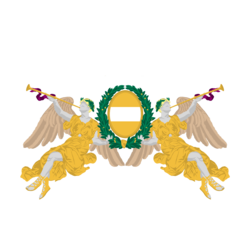List of Tengarian Monarchs: Difference between revisions
No edit summary |
No edit summary |
||
| Line 2: | Line 2: | ||
| royal_title = Monarchy | | royal_title = Monarchy | ||
| realm = Tengaria | | realm = Tengaria | ||
| coatofarms = | | coatofarms = TengarianMonarchsCOA.png | ||
| coatofarmssize = | | coatofarmssize = 300px | ||
| coatofarmscaption = | | coatofarmscaption = Personal Arms of the Emperors of the Solarians | ||
| image = Његово_Краљевско_Височанство_Принц_Наследник_Петар_Карађорђевић_од_Србија.jpg | | image = Његово_Краљевско_Височанство_Принц_Наследник_Петар_Карађорђевић_од_Србија.jpg | ||
| caption = [[Vasil VI, Emperor of Tengaria|Vasil VI]], claimant to the Tengarian Crown | | caption = [[Vasil VI, Emperor of Tengaria|Vasil VI]], claimant to the Tengarian Crown | ||
| first_monarch = [[Vasil I, Grand Prince of Tengaria|Vasil I 'the Strong']]<br/><small>(as | | first_monarch = [[Vasil I, Grand Prince of Tengaria|Vasil I 'the Strong']]<br/><small>(as Vicar)</small> | ||
| last_monarch = [[Dragomir III, Emperor of Tengaria|Dragomir III 'the Misfortunate']]<br/><small>(as | | last_monarch = [[Dragomir III, Emperor of Tengaria|Dragomir III 'the Misfortunate']]<br/><small>(as Imperator)</small> | ||
| style = {{wp|Imperial Majesty (style)|His Imperial Majesty}} | | style = {{wp|Imperial Majesty (style)|His Imperial Majesty}} | ||
| residence = | | residence = {{wp|Mikhailovsky Palace|Yellow Palace}} | ||
| appointer = Hereditary | | appointer = Hereditary-elective | ||
| began = | | began = 1121 (Vicariate) <br> 1385 (Empire) | ||
| ended = 1935 | | ended = 1935 | ||
| pretender = [[Vasil VI, Emperor of Tengaria|Vasil VI 'the True']] | | pretender = [[Vasil VI, Emperor of Tengaria|Vasil VI 'the True']] | ||
}} | }} | ||
The '''Monarchs of Tengaria''' | The following '''List of Tengarian Monarchs''' is taken from the period of monarchical systems of rule over the geographical area of Tengaria, also sometimes called the '''Tengarian Monarchy'''. The first period began with the establishment the [[Vicariate of Tengaria]] as an prominent subdivision of the [[Empire of Arciluco]] around the year 1121, and the second being the [[Empire of Tengaria]] in 1385 as the successor to the Empire of Arciluco. Notably, these monarchs claimed to be Solarian; the term "Tengarian monarch" is an {{wp|exonym}} of foreign scholarship. The second period of monarchical ended with the annexation of Tengaria by the Amathians in 1930 and subsequently the proclamation of the [[Tengaria|Republic of Tengaria]] in 1935. The monarchy was never formally abrogated but is considered ''de facto'' defunct. | ||
The | The Vicariate comprised the western reaches of the Empire of Arciluco, with the title of the leader being the ''Vicarius et Comes Occidentalis'', commonly rendered in Estmerish as simply "Vicar". The ''Vicarius et Comes'' one of the 3 most powerful positions in the Empire, alongisde the ''Magister Utriusque Militiae'' and the Eastern ''Vicarius''. Originally a military title, over time it became an established and ''de facto'' hereditary executive office over the Empire's western marches, although hereditary rule was not always successful. The Vicarii were very engaged with Imperial politics, and were not sovereign rulers. Nevertheless, the core of their territory largely extended over the modern territory of Tengaria. | ||
After the fall of the Empire of Arciluco into the [[Realm of Thorns]] | After the fall of the eastern half of the Empire of Arciluco into the iconoclastic [[Realm of Thorns]], the Western half of the Empire consolidated under the iconodule ''Vicarius''. The exiled Ecumenical Patriarch Alexander III, alongside the icondule bishops and logofeți, proclaimed the Vicar as the new ''[[Domnitor (Arciluco)|Domnitor]]''. The city of Arciluco was not able to be reconquered, resulting in the new Emperors transfering the Imperial capital to [[Lenovo]] in the ''translatio Imperii''. This political entity, although it was in many ways a continuation of the old Empire of Arciluco, is considered by foreign historians as a seperate state. As part of several stylistic changes in the ''translatio Imperii'', the old Solarian title ''Imperator'' was re-adopted alongside the traditional Arcilucan Domnitor. | ||
Despite claiming an Imperial title, many East Euclean countries adressed as the monarch as a 'king', either out of indifference, ignorance or as an insult. Some have refused to recognise their connection with Solaria, as the Tengarians had never been part of the [[Solarian Empire]], or believed that the Gaullican or resurgent Amathian claim was more proper. Others viewed the Empire in decline as not worthy of the title. Imperial apologists defended it, however, saying that the ''Imperi'' had rightfully been translated from Solaria to Arciluco to Tengaria because of divine providence and their faithfulness through means of the Ecumenical Patriarch, just as the kingly right of Saul was given to David. | |||
The | The Emperors largely followed an evolved version of the Arciculan honorifics, combining the style of the Arcilucan Emperors with their {{wp|Orthodoxy}} and {{wp|universal monarchy|universal authority}}: | ||
*Estmerish: ''"Hail, [Emperor's name], in Sotiras the God and through the Grace of the Holy Trinity, Imperator and Domnitor of the Solarians and all Sotirians"'' | |||
*Solarian: ''"Io, [Emperor's name], in Sotira Deo et per gratiam Sanctae Trinitatis, Imperator et Domnitor Solarianorum Sotirianorumque omnium"'' | |||
*[[Tengarian language|Tengarian]]: ''"Io, [Emperor's name], in Sotiras Deu și ob gratiam Treime Svete, Imperator și Domnitor Solarnū Sotirianūși totū"'' | |||
Following in the manner of Arciluco, Imperial succession was primarily hereditary, with all Emperors being descendants of [[Cyriacus the Elder]] and part of the larger Cyriacan Dynasty, although multiple cadet branches existed, coming from the old Ariculcan ''os de domn'' and ''nobilime de sânge'', although the restrictions for eligibility were elevated to disclude bastards and the female-line. According to law, the new Emperor was to be elected by the ''Aduna Mara'', a body which consisted of the Endemic Synod, Senate, and other officials within the imperial bureaucracy, presided over by the [[Patriarchate of Istros|Patriarch of Istros]]. Because the authority of the Emperors was seen as coming from Divine Authority, the Patriarch received a right to veto and also was the one who crowned the new Emperor. In practice, succession was much more stable than the old Arcilucan system and largely followed a pattern of {{wp|Primogeniture#Agnatic_primogeniture|Agnatic Primogeniture}} succession as common in other Euclean dynasties. However, there were notable exceptions where the ''Aduna Mara'' exercised its authority. | |||
==[[ | The Tengarian monarchy has not had an active ruler since 1935, but there have been several claimants to the throne, following the order of seniority in the Cyriacan dyansty (''Domu Cyriaci''). Since 1948, they have resided within Tengaria. | ||
==[[Vicariate of Tengaria]] (1121-1385)== | |||
{| class="wikitable" style="width:100%;" | {| class="wikitable" style="width:100%;" | ||
|- style="background:#D4F2CE;" | |- style="background:#D4F2CE;" | ||
! style="background:# | ! style="background:#f8f9a4; width:8%;" | Image | ||
! style="background:# | ! style="background:#f8f9a4; width:8%;" | Life Years | ||
! style="background:# | ! style="background:#f8f9a4; width:12%;"| Name | ||
! style="background:# | ! style="background:#f8f9a4; width:8%;" | Reign | ||
! style="background:# | ! style="background:#f8f9a4; width:64%;" | Notes/Death | ||
|- | |- | ||
| colspan="5" style="background: # | | colspan="5" style="background: #efde09; text-align: center;" | Non-dynastic (1121-1197) | ||
|- | |- | ||
| | | || 1069-1125 || [[Gavril, Grand Prince of Tengaria|Gavril]] || 1111–1125 || Tengarian General. Ascended to the throne after deposing Boris II. | ||
|- | |- | ||
| | | || 1094-1165 || [[Geto I, Grand Prince of Tengaria|Geto I]] || 1125–1165 || Son of Gavril. Died of old age in 1165. | ||
|- | |- | ||
| | | || 1119-1191 || [[Biser, Grand Prince of Tengaria|Biser]] || 1165–1191 || Son of Geto. Died of Illness in 1191. | ||
|- | |- | ||
| | | || 1141-1206 || [[Geto II, Grand Prince of Tengaria|Geto II]] || 1191–1199 || Son of Biser. Rebelled against the Emperor. Deposed and exiled in 1199 combined forces of Arciluco and the Tengarian general Dragan. | ||
|- | |- | ||
| colspan="5" style="background: # | | colspan="5" style="background: #efde09; text-align: center;" | [[Cyriacus the Elder|Cyriacan Dynasty]] (1199-1299) | ||
|- | |- | ||
| | | || 1169-1244 || [[Dragan, Grand Prince of Tengaria|Dragan]] || 1199–1244 || Tengarian General. Ascended to the throne after deposing Geto II with support from the Emperor of Arciluco. | ||
|- | |- | ||
| | | || 1194-1253 || [[Dragomir I, Grand Prince of Tengaria|Dragomir I]] || 1244–1250 || Son of Dragan. Deposed by his son Krasimir. | ||
|- | |- | ||
| | | || 1219-1285 || [[Krasimir, Grand Prince of Tengaria|Krasimir]] || 1250–1285 || Son of Dragomir I. Died of natural causes in 1285. | ||
|- | |- | ||
| | | || 1244-1295 || [[Dragomir II, Grand Prince of Tengaria|Dragomir II]] || 1285–1295 || Son of Krasimir. Murdered on orders of his nephew, Boyan. | ||
|- | |- | ||
| | | || 1277-1301 || [[Boyan, Grand Prince of Tengaria|Boyan]] || 1295–1299 || Nephew of Dragomir. Deposed, blinded and exiled in 1299. | ||
|- | |- | ||
| colspan="5" style="background: # | | colspan="5" style="background: #efde09; text-align: center;" | [[House of Prostov|Prostov dynasty]] (1299-1385) | ||
|- | |- | ||
| | | || 1255-1323 || [[Vasil III, Grand Prince of Tengaria|Vasil III]] || 1299–1323 || Tengarian noble. Died of natural causes. | ||
|- | |- | ||
| | | || 1300-1334 || [[Ivan II, Grand Prince of Tengaria|Ivan II]] || 1323–1334 || Grandson of Vasil III. Slain in battle in 1334. | ||
|- | |- | ||
| | | || 1322-1370 || [[Vasil IV, Grand Prince of Tengaria|Vasil IV]] (1st) || 1334–1336 || Son of Ivan II. Assumed the throne at 12 years of age. Deposed by his regent uncle in 1336. | ||
|- | |- | ||
| | | || 1302-1344 || [[Simeon, Grand Prince of Tengaria|Simeon]] || 1336–1344 || Brother of Ivan II. Usurped the throne from his nephew. Slain in battle in 1344 fighting against Vasil IV. | ||
|- | |- | ||
| | | || 1322-1370 || [[Vasil IV, Grand Prince of Tengaria|Vasil IV]] (2nd) || 1344–1370 || Son of Ivan II. Restored to the throne after a successful war. Died of an illness in 1370. | ||
|- | |- | ||
| [[File:Manuel_II_Paleologus.jpg|100px]] || 1343-1407 || [[St. Vasil I, Emperor of Tengaria|Vasil V]] || 1370–1385 || Son of Vasil IV. Kept Tengarian iconodule during the Iconoclast Controversy. After the fall of [[Empire of Arciluco]], Ecumenical Patriarch Alexander III proclaimed his as Emperor, ending the Grand Principality and beginning the [[Empire of Tengaria]]. | | [[File:Manuel_II_Paleologus.jpg|100px]] || 1343-1407 || [[St. Vasil I, Emperor of Tengaria|Vasil V]] || 1370–1385 || Son of Vasil IV. Kept Tengarian iconodule during the Iconoclast Controversy. After the fall of [[Empire of Arciluco]], Ecumenical Patriarch Alexander III proclaimed his as Emperor, ending the Grand Principality and beginning the [[Empire of Tengaria]]. | ||
| Line 99: | Line 86: | ||
{| class="wikitable" style="width:100%;" | {| class="wikitable" style="width:100%;" | ||
|- style="background:#D4F2CE;" | |- style="background:#D4F2CE;" | ||
! style="background:# | ! style="background:#f8f9a4; width:8%;" | Image | ||
! style="background:# | ! style="background:#f8f9a4; width:8%;" | Life Years | ||
! style="background:# | ! style="background:#f8f9a4; width:12%;"| Name | ||
! style="background:# | ! style="background:#f8f9a4; width:8%;" | Reign | ||
! style="background:# | ! style="background:#f8f9a4; width:64%;" | Notes/Death | ||
|- | |- | ||
| colspan="5" style="background: #efde09; text-align: center;" | [[Cyriacus the Elder|Cyriacan Dynasty]] (1199-1299) | |||
| colspan="5" style="background: # | |- | ||
| colspan="5" style="background: #efde09; text-align: center;" | [[House of Prostov]] (1385-1604) | |||
|- | |- | ||
| [[File:Manuel_II_Paleologus.jpg|100px]] || 1343-1407 || [[St. Vasil I, Emperor of Tengaria|St. Vasil I]] (''St. Vasil the Great'') || 1385–1407 || Under his reign, the Tengarian Renaissance begins. He founds the [[University of Lenovo]]. Dies peacefully in 1407 on the brink of the Iconoclast Wars. Outlived his eldest son Vasil. Later proclaimed a Saint. | | [[File:Manuel_II_Paleologus.jpg|100px]] || 1343-1407 || [[St. Vasil I, Emperor of Tengaria|St. Vasil I]] (''St. Vasil the Great'') || 1385–1407 || Under his reign, the Tengarian Renaissance begins. He founds the [[University of Lenovo]]. Dies peacefully in 1407 on the brink of the Iconoclast Wars. Outlived his eldest son Vasil. Later proclaimed a Saint. | ||
Revision as of 06:01, 26 December 2023
| Monarchy of Tengaria | |
|---|---|
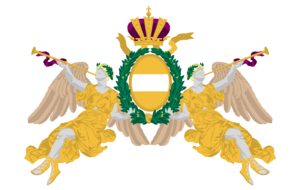 Personal Arms of the Emperors of the Solarians | |
 Vasil VI, claimant to the Tengarian Crown | |
| Details | |
| Style | His Imperial Majesty |
| First monarch | Vasil I 'the Strong' (as Vicar) |
| Last monarch | Dragomir III 'the Misfortunate' (as Imperator) |
| Formation | 1121 (Vicariate) 1385 (Empire) |
| Abolition | 1935 |
| Residence | Yellow Palace |
| Appointer | Hereditary-elective |
| Pretender(s) | Vasil VI 'the True' |
The following List of Tengarian Monarchs is taken from the period of monarchical systems of rule over the geographical area of Tengaria, also sometimes called the Tengarian Monarchy. The first period began with the establishment the Vicariate of Tengaria as an prominent subdivision of the Empire of Arciluco around the year 1121, and the second being the Empire of Tengaria in 1385 as the successor to the Empire of Arciluco. Notably, these monarchs claimed to be Solarian; the term "Tengarian monarch" is an exonym of foreign scholarship. The second period of monarchical ended with the annexation of Tengaria by the Amathians in 1930 and subsequently the proclamation of the Republic of Tengaria in 1935. The monarchy was never formally abrogated but is considered de facto defunct.
The Vicariate comprised the western reaches of the Empire of Arciluco, with the title of the leader being the Vicarius et Comes Occidentalis, commonly rendered in Estmerish as simply "Vicar". The Vicarius et Comes one of the 3 most powerful positions in the Empire, alongisde the Magister Utriusque Militiae and the Eastern Vicarius. Originally a military title, over time it became an established and de facto hereditary executive office over the Empire's western marches, although hereditary rule was not always successful. The Vicarii were very engaged with Imperial politics, and were not sovereign rulers. Nevertheless, the core of their territory largely extended over the modern territory of Tengaria.
After the fall of the eastern half of the Empire of Arciluco into the iconoclastic Realm of Thorns, the Western half of the Empire consolidated under the iconodule Vicarius. The exiled Ecumenical Patriarch Alexander III, alongside the icondule bishops and logofeți, proclaimed the Vicar as the new Domnitor. The city of Arciluco was not able to be reconquered, resulting in the new Emperors transfering the Imperial capital to Lenovo in the translatio Imperii. This political entity, although it was in many ways a continuation of the old Empire of Arciluco, is considered by foreign historians as a seperate state. As part of several stylistic changes in the translatio Imperii, the old Solarian title Imperator was re-adopted alongside the traditional Arcilucan Domnitor.
Despite claiming an Imperial title, many East Euclean countries adressed as the monarch as a 'king', either out of indifference, ignorance or as an insult. Some have refused to recognise their connection with Solaria, as the Tengarians had never been part of the Solarian Empire, or believed that the Gaullican or resurgent Amathian claim was more proper. Others viewed the Empire in decline as not worthy of the title. Imperial apologists defended it, however, saying that the Imperi had rightfully been translated from Solaria to Arciluco to Tengaria because of divine providence and their faithfulness through means of the Ecumenical Patriarch, just as the kingly right of Saul was given to David.
The Emperors largely followed an evolved version of the Arciculan honorifics, combining the style of the Arcilucan Emperors with their Orthodoxy and universal authority:
- Estmerish: "Hail, [Emperor's name], in Sotiras the God and through the Grace of the Holy Trinity, Imperator and Domnitor of the Solarians and all Sotirians"
- Solarian: "Io, [Emperor's name], in Sotira Deo et per gratiam Sanctae Trinitatis, Imperator et Domnitor Solarianorum Sotirianorumque omnium"
- Tengarian: "Io, [Emperor's name], in Sotiras Deu și ob gratiam Treime Svete, Imperator și Domnitor Solarnū Sotirianūși totū"
Following in the manner of Arciluco, Imperial succession was primarily hereditary, with all Emperors being descendants of Cyriacus the Elder and part of the larger Cyriacan Dynasty, although multiple cadet branches existed, coming from the old Ariculcan os de domn and nobilime de sânge, although the restrictions for eligibility were elevated to disclude bastards and the female-line. According to law, the new Emperor was to be elected by the Aduna Mara, a body which consisted of the Endemic Synod, Senate, and other officials within the imperial bureaucracy, presided over by the Patriarch of Istros. Because the authority of the Emperors was seen as coming from Divine Authority, the Patriarch received a right to veto and also was the one who crowned the new Emperor. In practice, succession was much more stable than the old Arcilucan system and largely followed a pattern of Agnatic Primogeniture succession as common in other Euclean dynasties. However, there were notable exceptions where the Aduna Mara exercised its authority.
The Tengarian monarchy has not had an active ruler since 1935, but there have been several claimants to the throne, following the order of seniority in the Cyriacan dyansty (Domu Cyriaci). Since 1948, they have resided within Tengaria.
Vicariate of Tengaria (1121-1385)
| Image | Life Years | Name | Reign | Notes/Death |
|---|---|---|---|---|
| Non-dynastic (1121-1197) | ||||
| 1069-1125 | Gavril | 1111–1125 | Tengarian General. Ascended to the throne after deposing Boris II. | |
| 1094-1165 | Geto I | 1125–1165 | Son of Gavril. Died of old age in 1165. | |
| 1119-1191 | Biser | 1165–1191 | Son of Geto. Died of Illness in 1191. | |
| 1141-1206 | Geto II | 1191–1199 | Son of Biser. Rebelled against the Emperor. Deposed and exiled in 1199 combined forces of Arciluco and the Tengarian general Dragan. | |
| Cyriacan Dynasty (1199-1299) | ||||
| 1169-1244 | Dragan | 1199–1244 | Tengarian General. Ascended to the throne after deposing Geto II with support from the Emperor of Arciluco. | |
| 1194-1253 | Dragomir I | 1244–1250 | Son of Dragan. Deposed by his son Krasimir. | |
| 1219-1285 | Krasimir | 1250–1285 | Son of Dragomir I. Died of natural causes in 1285. | |
| 1244-1295 | Dragomir II | 1285–1295 | Son of Krasimir. Murdered on orders of his nephew, Boyan. | |
| 1277-1301 | Boyan | 1295–1299 | Nephew of Dragomir. Deposed, blinded and exiled in 1299. | |
| Prostov dynasty (1299-1385) | ||||
| 1255-1323 | Vasil III | 1299–1323 | Tengarian noble. Died of natural causes. | |
| 1300-1334 | Ivan II | 1323–1334 | Grandson of Vasil III. Slain in battle in 1334. | |
| 1322-1370 | Vasil IV (1st) | 1334–1336 | Son of Ivan II. Assumed the throne at 12 years of age. Deposed by his regent uncle in 1336. | |
| 1302-1344 | Simeon | 1336–1344 | Brother of Ivan II. Usurped the throne from his nephew. Slain in battle in 1344 fighting against Vasil IV. | |
| 1322-1370 | Vasil IV (2nd) | 1344–1370 | Son of Ivan II. Restored to the throne after a successful war. Died of an illness in 1370. | |
 |
1343-1407 | Vasil V | 1370–1385 | Son of Vasil IV. Kept Tengarian iconodule during the Iconoclast Controversy. After the fall of Empire of Arciluco, Ecumenical Patriarch Alexander III proclaimed his as Emperor, ending the Grand Principality and beginning the Empire of Tengaria. |
Empire of Tengaria (1385-1930)
| Image | Life Years | Name | Reign | Notes/Death |
|---|---|---|---|---|
| Cyriacan Dynasty (1199-1299) | ||||
| House of Prostov (1385-1604) | ||||
 |
1343-1407 | St. Vasil I (St. Vasil the Great) | 1385–1407 | Under his reign, the Tengarian Renaissance begins. He founds the University of Lenovo. Dies peacefully in 1407 on the brink of the Iconoclast Wars. Outlived his eldest son Vasil. Later proclaimed a Saint. |
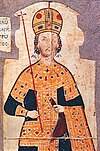 |
1387-1446 | Vasil II (Vasil the Bold) | 1407–1446 | Grandson of Vasil I. Lead Tengaria during the Iconoclast Wars. Died of natural causes in 1446. |
 |
1410-1473 | Dragomir I (Dragomir the Timid) | 1446–1473 | Son of Vasil II. Died of an illness in 1473. |
 |
1453-1521 | Ivan I (Ivan the Just) | 1473–1521 | Grandson of Dragomir I. Died without issue in 1521. |
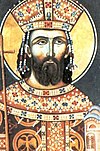 |
1478-1544 | Boris I (Boris the Vainglorious) | 1521–1544 | Nephew of Ivan I. Killed in battle in 1544. |
 |
1501-1546 | Boris II (Boris the Brief) | 1544–1546 | Son of Boris I. Died of suspicious circumstances in 1546. |
 |
1523-1555 | Boris III (Boris the Sickly) | 1546–1555 | Son of Boris II. Died of an illness in 1555. |
 |
1545-1558 | Boris IV (Boris the Lost) | 1555–1558 | Son of Boris III. Became Emperor at age 10. Disappeared without a trace in 1558; his uncle assumed the office of Emperor. It is suspected that he is murdered. |
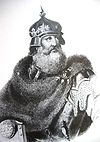 |
1526-1588 | Krasimir (Krasimir the Cruel) | 1558–1588 | Son of Boris II. Became Emperor after the disappearance of Boris IV. |
 |
1550-1604 | Ivan II (Ivan the Sonless) | 1588–1604 | Son of Krasimir. Died with no sons, his son-in-law Simeon took power after his natural death in 1555. Last ruler of the mainline Prostov Dynasty. |
| House of Moshtnov (1604-1769) | ||||
 |
1581-1667 | Simeon I (Simeon the Long-Lived) | 1604–1667 | Distant scion of the house of Postrov and Lord of Moshtnov. Came to the throne both by agnatic succession and by right of his wife, Anastasia, the daughter of Ivan II. Outlived his son and grandson. Died of old age in 1667. |
 |
1642-1689 | Vladislav (Vladislav the Unready) | 1667–1689 | Great-grandson of Simeon I. Died of childless, possibly murdered by his brother. |
 |
1645-1701 | Gregori I (Gregori the Oppurtunist) | 1689–1701 | Brother of Vladislav. Died of natural causes in 1701. |
 |
1667-1709 | Gregori II (Gregori the Kind) | 1701–1709 | Son of Gregori I. Died of an illness in 1709. |
 |
1690-1745 | Gregori III (Gregori the Celibate) | 1709–1714 | Son of Gregori II. Deposed by his brother and sent to a monastery, where he lived out the rest of his life. |
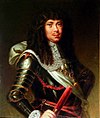 |
1692-1734 | Ivan III (Ivan the Usurper) | 1714–1734 | Son of Gregori II. Took the throne from his brother and ruled for himself. Crushed several rebellions during the course of his reign. |
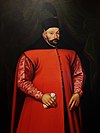 |
1715-1769 | Ivan IV (Ivan the Barren) | 1734–1769 | Son of Ivan III. Died childless, ending the Moshtnov dynasty. Willed the throne to Vasil, a distant relative and confidant. |
| House of Istrov (1769-1935) | ||||
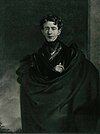 |
1729-1792 | Vasil III (Vasil the Restorer) | 1769–1792 | Distant male-line scion of the House of Prostov, a cadet branch which were Boyars of Istros. Died of natural causes in 1792. |
 |
1752-1799 | Vasil IV (Vasil the Forgotten) | 1792–1799 | Son of Vasil III. Died of natural causes in 1799. |
 |
1775-1823 | Vasil V (Vasil the Daughter-Bearer) | 1799–1823 | Son Vasil IV. Died with no sons in 1823, succeeded by his brother Simeon. |
 |
1778-1848 | Simeon II (Simeon the Fortunate) | 1823–1848 | Son of Vasil IV. Died after a period of illness in 1848. |
 |
1799-1889 | Simeon III (Simeon the Gregarious) | 1848–1889 | Son of Simeon II. Outlived his two oldest sons. Died of old age in 1889. |
 |
1839-1906 | Hristofor (St. Hristofor the Holy) | 1889–1906 | Grandson of Simeon III. Celibate. Died of an illness in 1906. Proclaimed a Saint. |
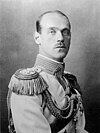 |
1866-1919 | Dragomir II (Dragomir the Resourceful) | 1906–1919 | Nephew of Hristofor. Kept Tengaria stable during the Great Collapse. Died of natural causes in 1915. |
 |
1888-1962 | Dragomir III (Dragomir the Misfortunate) | 1919–1935 | Son of Dragomir II. Emperor of Tengaria during the Great War, imprisoned by Ravnia in 1930 while attempting to sail to Ravnia. De facto deposed by Soravia when they demanded Tengaria become a Republic. |
Claimants to the Tengarian Throne (1935-present)
| Image | Life Years | Name | Reign | Notes/Death |
|---|---|---|---|---|
| House of Istrov (1935-present) | ||||
 |
1888-1962 | Dragomir III (Dragomir the Misfortunate) | 1935–1962 | Came back into Tengaria after the conclusion of the Tengarian Civil War, with the Imperial family's property restored to him, but not restored to power. Died of an illness in 1962. |
 |
1912-2004 | Dragomir (IV) (Dragomir the Venerable) | 1962–2004 | Eldest son of Dragomir III. Outlived both his son and grandson, and died of natural causes at the age of 92. |
 |
1979- | Vasil (VI) (Vasil the True) | 2004–present | Great-grandson of Dragomir IV. Current head of the House of Istrov, and claimant to the Imperial title. Member of the Senate of Tengaria. |
